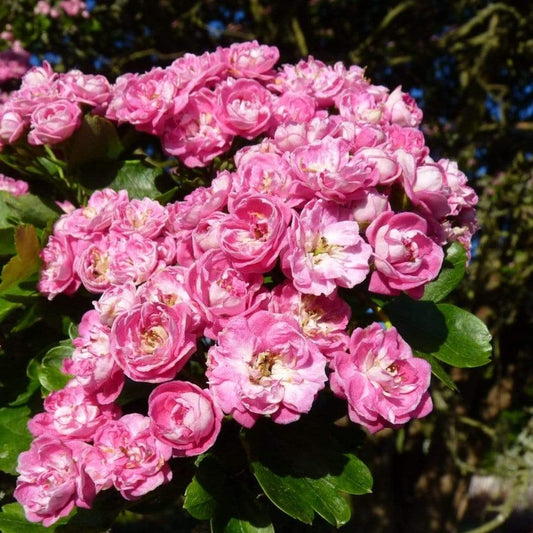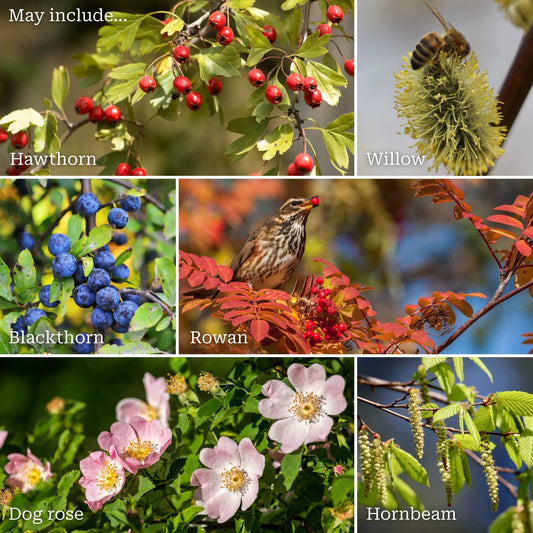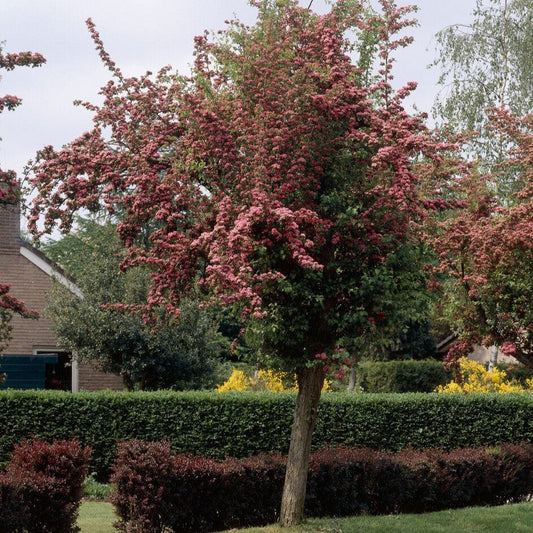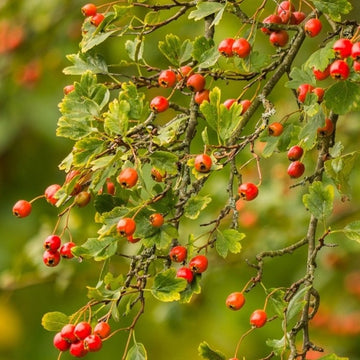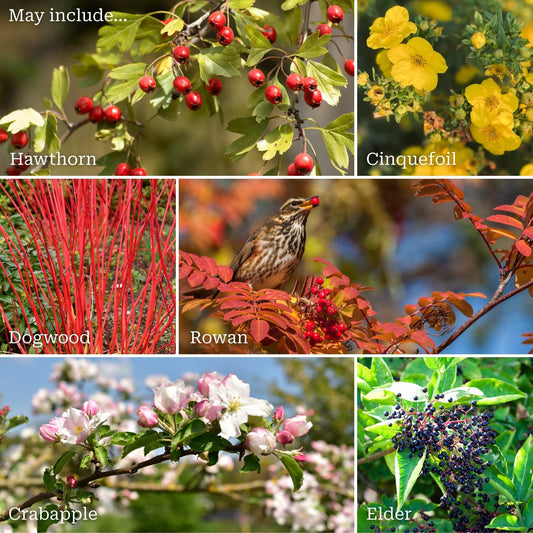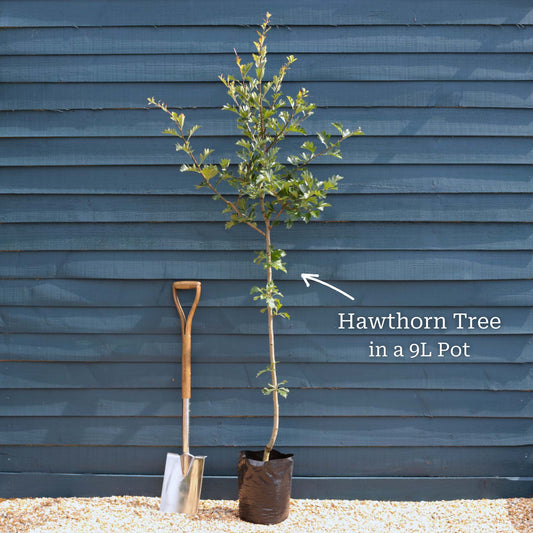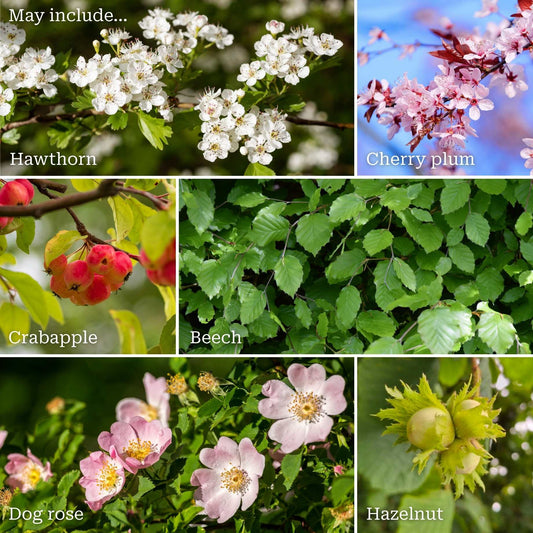Collection: Hawthorn Trees
One of the best native trees for wildlife, a single hawthorn tree can support 149 different insect species! Hawthorns are true four season trees, with glossy foliage and masses of flowers to attract bees in May and June. Red haws appear in the autumn which are loved by birds including fieldfares and redwings. Our growers in the New Forest have been growing hawthorn trees for over fifty years and selected the best performing varieties for us. Grown in the field in the traditional way, our hawthorns are incredibly hardy and tolerant of almost all conditions, making them a solid choice for any UK garden.
Need help picking?-
Regular price From £35Regular price
£54Sale price From £35Red Hawthorn Tree | Crataegus laevigata 'Paul's Scarlet'
Intensely vivid, hot pink blooms
- Round-crowned, bushy tree
- Medium tree - grows up to 8m
- Myriad fully-double pink blooms
- RHS Award of Garden Merit winner
2 options available
-
Regular price From £2Regular price
£5Sale price From £2Common Hawthorn Hedging | Crataegus monogyna
Supports over 150 wildlife species
- Scented spring blossom & autumn fruits
- Loved by bees and nesting birds
- Fast growth rate - 40-60cm per year
- Grows up to 8m or keep trimmed at 1-5m
3 options available
-
Regular price From £45Regular price
£60Sale price From £45Best Mixed Native Wildlife Hedging | Growers' Choice
An ecological haven
- Packed with colour, flowers & fruit
- Food and shelter for insects, birds & mammals
- UK native varieties handpicked by our grower
- Hardy and easy to maintain
2 options available
-
Regular price From £36Regular price Sale price From £36
Double Pink Hawthorn Tree | Crataegus laevigata 'Rosea Flore Pleno'
Double delight in punchy pink!
- Rounded, bushy tree
- Medium tree - grows up to 8m
- Fluffy, fully-double blooms in rose pink
- RHS Award of Garden Merit winner
1 option available
-
Regular price From £38Regular price
£40Sale price From £38Midland Hawthorn Tree | Crataegus laevigata ‘Crimson Cloud’
A true wildlife magnet
- Elegantly spreading tree
- Medium tree - grows up to 8m
- Masses of striking two-toned, single flowers
- RHS Plants for Pollinators
1 option available
-
Regular price From £38Regular price Sale price From £38
Broad-Leaved Cockspur Thorn Tree | Crataegus persimilis 'Prunifolia'
An unbeatable floral display
- Broad and bushy tree
- Medium tree - grows up to 5m
- Clusters of single white blooms in spring
- RHS Award of Garden Merit winner
2 options available
-
Regular price From £65Regular price
£70Sale price From £65Double White Hawthorn Tree | Crataegus laevigata 'Plena'
Masses and masses of flowers
- Beautifully rounded tree
- Medium tree - grows up to 5m
- Abundant double flowers in linen white
- RHS Award of Garden Merit winner
1 option available
-
Regular price From £45Regular price
£55Sale price From £45All Seasons Hedging | Growers' Choice
Looks great all year round
- Flowers, berries and vibrant stems
- Packed with colour and wildlife benefits
- Premium varieties handpicked by our grower
- Easy to plant and prune
4 options available
-
Regular price £70Regular price
£75Sale price £70Hybrid Cockspur Hawthorn | Crataegus x lavalleei 'Carrierei'
Holds leaves late into the year
- Broad, spreading tree
- Medium tree - grows up to 10m
- Stunning creamy-white single flowers
- RHS Award of Garden Merit winner
1 option available
-
Regular price From £60Regular price
£90Sale price From £60Livestock-Friendly Farm Hedging | BN11 Compliant
Ready-to-go natural barrier
- Benefits domestic and wild animals
- Ideal for farms, paddocks and smallholdings
- RPA and Natural England BN11 compliant
- Easy to plant and maintain
1 option available
-
Regular price From £65Regular price
£95Sale price From £65A Completely Edible Hedge
Turn borders into fruit gardens!
- Packed with fruit, nuts and berries
- Spring flowers loved by pollinators
- Tasty varieties handpicked by our grower
- Hardy, productive and easy to look after
Currently out of stock
South Downs National Park
Meet Danielle
110 years' expertise free with every tree
Danielle's nursery has been growing trees in the South Downs National Park for over a century, and it shows. Dug up and sent straight to your garden at between 18-36 months old, their quality rootstocks, expert pruning and natural pest control mean that these traditionally field-grown trees are the hardiest you can get.
Need help picking?

Which hawthorn tree is best for your garden?
Hawthorns are famed for their blossom, and Crimson Cloud Hawthorn is one of the best, with spectacular flowers turning from crimson red through pink to white, while Paul’s Scarlet has deep red flowers and the Double White Hawthorn Tree gives you those familiar white clouds. For smaller gardens, we love the award winning Broad leaved Cockspur, which grows to just 5x4m. It’s also one of the best for fruit, with bright crimson haws that stick around well into winter. For autumn colour, the Hybrid Cockspur is hard to beat, with a glorious range of red, purple and orange leaves. Find the right hawthorn for you with our easy guide.

What grows well with hawthorns?
A hawthorn tree can be the focal point of your wildlife friendly garden or a companion for other beautiful native woodland trees like oaks, willows and rowans. This is also one of the best trees you can plant for native wildlife - bees love the flowers and birds come for the all-you-can-eat fruit buffet in autumn - the sharp thorns also give them a safe nesting place amongst its branches. For something equally wildlife-friendly but smaller, try a crabapple tree or explore more UK native trees.

Growers' tips
Hawthorn trees are able to thrive in any type of soil (even chalk) as long as it’s fertile and well drained. You’ll get the best flowers by planting your hawthorn in full sun, but they grow perfectly well in partial shade too. As hawthorn trees have naturally well-shaped canopies, they don't need much pruning. Simply check your tree in late winter or early spring and prune out any dead, damaged, diseased or crossing branches. Water your hawthorn tree well for the first few months, then during hot and dry weather for the first couple of years. After that your established tree will have developed its drought tolerance and will get by on natural rainwater.
Happy plants make happy customers

Plants arrived in great condition and very promptly. Well established - much better than the ones I got at my local garden centre.
Monica Spence
| 24 May
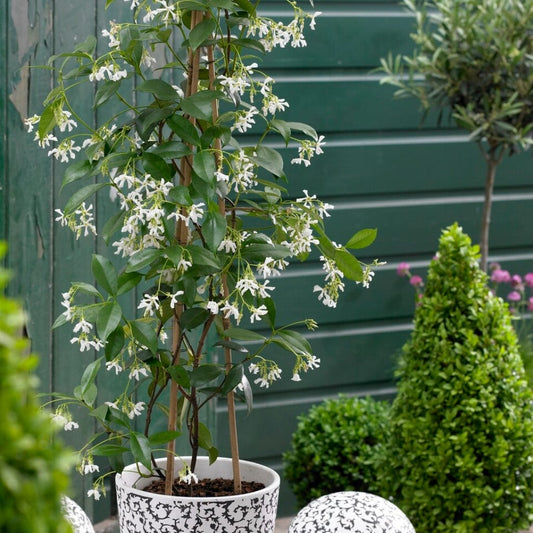
Yet again this company delivered good healthy plants, exactly as shown in photos, well packaged and within delivery time quoted. Recommend!
Jacqueline Burgess
| 2 Jun

I continue to be so impressed with Roots. Their customer care, knowledge of their subject: from planting hedges to pruning roses and more, has been a great support.
Judy Lane
| 23 Oct

The plant arrived looking vigorously healthy, which brings a smile to your face, extremely well protected in its packaging.
Martyn Hill
| 5 Jul

As a non-gardener, I found my whole experience brilliant. Great information & advice available on the website, great range of products & prices are brilliant.
John-Paul
| 22 May

Wonderful plants and great customer service... really surprised to find that the plants are better than those you would get at your local garden centre.
Gavin Wilcock
| 8 Nov
Fighting plastic waste
Delivering fresh from the nursery
Supporting UK growers


